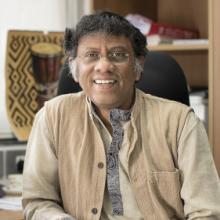 gopakumar
gopakumar  icts
icts res
res in
in
CV List of Publications Some Talk Slides
Academic Profile:
Rajesh Gopakumar did his undergraduate degree in Physics from IIT-Kanpur and went on to do his Ph.d. at Princeton University. After being a research associate at Harvard University he moved to Harish-Chandra Research Institute in 2001 as Associate Professor and then Professor. He was also a visiting long-term member at the Insitute for Advanced Study, Princeton from 2001-2004. He is the recipient of the ICTP Prize - in honour of G. C. Wick (2006), the S.S. Bhatnagar Award (2009), the Swarnajayanthi Fellowship (2006), the J. C. Bose Fellowship (2015), the G. D. Birla Prize (2013) and the TWAS Prize in the Physical Sciences (2013). He is also a Fellow of the Indian Academy of Sciences, the Indian National Science Academy and the National Academy of Sciences, India. He was elected fellow of the The World Academy of Sciences (TWAS) in 2015. He is a founding member (now alumnus) of the Global Young Academy (GYA).
Research Interests:
Rajesh Gopakumar's interests are in theoretical physics, primarily at the intersection of quantum field theory and string theory. He would like to understand why string theory is a natural framework for describing a variety of phenomena. In particular, a lot of his research has focused on deciphering the AdS/CFT correspondence.
This has included uncovering a new example of this correspondence (minimal model holography) and using it to understand the unbroken symmetries of string theory. His work on topological string theory and the duality with Chern-Simons theory stems from the same motivation. Other works on topological string theory have had applications to enumerative invariants. He has also worked on non-commutative field theories, non-relativistic conformal algebras like the GCA and other topics in string theory. A recurring, unifying theme has also been understanding the large N limit of gauge theories which began with his thesis work on the master field.
Conferences


